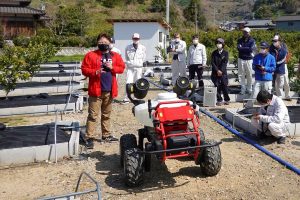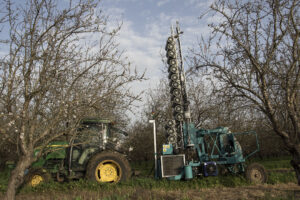Automating pollination – is it practical or affordable?

Whether in response to labour issues, a want of better production efficiency, or the perception that pollinator numbers are declining, companies are continuing to invest in mechanical pollination technology. The question – is mechanical pollination in a field or orchard setting actually practical or affordable?
Peter Kevan, a University of Guelph researcher specializing in applied ecology, pollination biology, apiculture, plant breeding systems, and other areas of ecology provides his thoughts on two concurrent examples of the technology.
XAG R150

Chinese company XAG markets its small autonomous vehicle, the R150, as a multi-purpose piece of farm machinery. From chemical application to general labour-saving weight capabilities, the R150 has been used in a variety of countries, including The United Kingdom, Australia, and Japan.
This summer, it’s ability to apply an atomized pollen solution in Japanese apple orchards was showcased. Pollen is applied from the ground up as the R150 makes its way down the orchard row, with an operator retaining control of spray angle and spread via their smartphone.
According to both reports of the demonstration and marketing associated with the machine, the R150’s ability to apply pollen on-demand is intended to be a safeguard against what is alleged to be Japan’s declining number of bee swarms. Its labour-saving capability, including the subsequent need for fewer employees – which are hard to attract in the first place – are also emphasized.
An extension of input application tech
Kevan believes equipment such as the R150 represent the constant interest and advancement in input application technology generally. Indeed, he likens its use to similar initiatives in drone-based input application. And given the diversity of agriculture globally, such technologies are bound to find a fit somewhere.
Finding the right price point is critical. In a country where inputs are more expensive, like Japan, says Kevan, the cost of purchasing and using a machine like the R150 might make sense, but in places where the general cost of things is much lower, it may not. When contacted directly, XAG had yet to respond to questions about the R150’s cost at the time of this writing. “All these things are worth trying from the economics and practicality of it. Who knows?,” Kevan says.
Pull-type pollen applicator
Citing the perceived decline of pollinators worldwide, Israeli start-up company Edete has developed and trialed a mechanical pollination system they say will help ensure the continued production of nutritious food. Via vertical booms, its tow-behind pollination the system shoots pollen at flowering trees as it’s driven down the orchard row.
Text continues underneath video
The technology relies on a two-step system, starting with a specific pollen harvesting process where Edete mechanically harvests flowers, separates, and stores pollen in two separate production facilities. According to the company, this process ensures pollen remains viable for a considerable period of time, and overcomes “the problem of desynchronization of different cultivars’ blooms.” That is, accounting for the specific pollination needs of different crop species.
Once in the orchard, pollen is blown onto trees using the company’s 2B mechanical pollinator unit. LIDAR sensors are used to apply the pollen from the most effective distance to each part of the tree. As described on the company’s website, 2B units can operate day and night. They are also quick in covering any open flower in range, and not limited by low temperatures. Growers also have the ability to match the best pollen to their crops, and at the most optimal time, guaranteeing or potentially increasing yield.
The potential is there. It’s one of these things I think should be tried
As with the R150, Kevan perceives Edete’s 2B unit could be an effective method of improving yields, harvest timing, and other production factors – at least in higher value crops. Because pollination via bees also doesn’t happen in adverse weather conditions, mechanical methods could be used during those times. In lower value field crops, such as canola, it might also be useful in the production of hybrids.
“The potential is there. It’s one of these things I think should be tried, but ultimately, whether its going to be cost effective, that to me is really what we get down to.”
An expensive process

Fundamentally, Kevan says Edete and XAG’s investments represent the latest in a long line of mechanical pollination innovation. Many methods have been tried, from expensive strategies such as blasting pollen via helicopter to time consuming manual pollination – the latter approach dating to prehistoric times.
“The same sorts of techniques generally have been suggested for the dissemination of biological control agents. This is much the same sort of thing,” he says, adding the practicality of pollen collection remains a stumbling block.
“Costs have to include gathering pollen in order to put it in the machine…There’s a whole technology associated with that. Getting it collected for more artificial distribution, that’s been worked out for a few economically important plants. That would include pome fruits and probably almonds.”
Variability of pollen types
A complicating factor is the variability of pollen types, and how long they stay viable. Some pollen is only viable for a few minutes after being released from the plant. If that’s the type of pollen required for a crop, extraction, delivery, and application would be even more challenging.
Overall, Kevan is unsure if those developing mechanical pollination technologies are asking the right questions – or more specifically, putting enough effort towards understanding the nuances of natural pollination.
Someone has to do the cost benefit. We haven’t been able to get anywhere with that
He describes the introduction of self-compatible sunflowers as an illustrative example. When the varieties were introduced to North American several decades ago, growers were led to believe they would not need pollinators. Unfortunately, seed quality turned out to be poor compared to those from cross-pollinated plants. A similar challenge occurred with soybeans in Brazil, where growers determined the presence of honeybees helped pods develop more seeds.
Canada’s honeybee population is doing well
“Someone has to do the cost benefit. We haven’t been able to get anywhere with that, not in Canada with the major seed producing companies.” Additionally, Kevan reiterates many pollinator populations are not declining. Canada’s honeybee population, for example, is doing well, as is Mexico’s. The two countries contrast with the United States, where beekeepers have in fact seen major declines.
Declines in wild pollinators are a concern too. However, Kevan cautions there is a large gulf between dropping populations and claims of imminent global food catastrophe – claims which continue to be cited by those marketing mechanical pollination equipment.
“We definitely need to be watching our pollinators, and beekeepers have every right to be concerned about losing their bee stocks to diseases and pesticides and various other things,” he says. “But it’s a jump from the rusty patch bee is in decline, therefore food prices are going to shoot up 50 per cent. That’s adding two and two, and making 24.”
 Beheer
Beheer



 WP Admin
WP Admin  Bewerk bericht
Bewerk bericht